The Roots
The Kingdom's prophet and founder, Frank W. Sandford, was born on a farm in the rural town
of Bowdoinham, Maine October 2, 1862. His father having passed on at an early age, Frank's
mother assumed a more dominant role during his formative years. Raised a Freewill Baptist
but a cut-up none the less, Frank went through a conversion experience in February of
1880. He enrolled at what is today Bates College in Lewiston, Maine, and according to his
own autobiography, Seven Years With God, became very popular and a talented star
of the college baseball team.
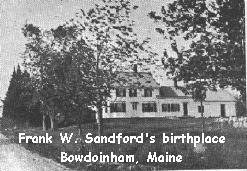
The following excerpts, dealing with spiritual background, personality and character, are highlights from William Hiss's dissertation on Sandford and The Kingdom.
"...in baseball and in everything else he later did, Sandford was driven by a desire for victory. He could never pretend that victory did not matter, especially in his later religious work when the stakes were literally, as he saw it, the salvation of the world. In his "retirement", he often spoke to his followers about his baseball days and ministry saying, "Oh, I wish I could convey to you young fellows how my soul loves the victory." He despised a compromise or a draw with an almost visceral intensity. In later life the images of his sermons and hymns, the architecture of his buildings, and his dramatic spiritual battles were all intensely colored by the leitmotif of warfare, struggle, and eventual victory." Hiss pp. 47
"...Frank Sandford and many conservative Protestants saw themselves as spiritually discontented and ambitious. They wanted nothing less than perfection for themselves and the world... and so... they struck off for themselves to form the new organizations which collectively came to be known as the "higher lines" of evangelical Christianity." Hiss pp.57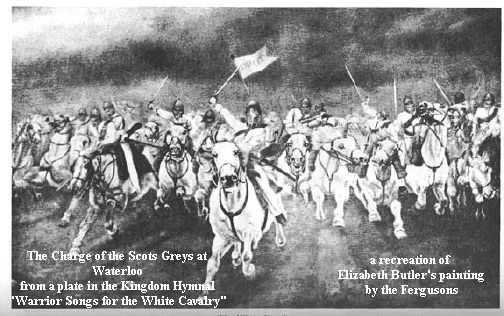
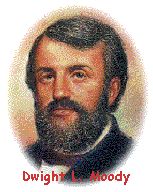
2) Moody offered Sandford a model in refusing a pastor’s salary
3) Moody’s preaching techniques,
• informal
• extemporaneous
• "All Scripture", citing chapter and verse of both old and new testaments from memory.
4) Saturdays were kept for rest, (later the "restored" Sabbath)
5) Year end New Year’s Eve "Watch Night" services
The Christian’s Secret of a Happy Life (Old Tappan, New Jersey: Fleming H. Revel Co., 1966)
Hannah Whitehall Smith’s book, The Christian’s Secret of a Happy Life
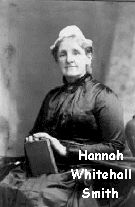
• Smith and her husband were both perfectionists
• Smith sought a church "glorious, holy, and without blemish"
• To her, Sanctification meant a willingness to abandon the self forever in a step of surrender and trust
• She made constant comparison to the "moderate Christians around you"
"The effect of this book on Sandford was shattering, emancipating and lasting." Hiss pp. 67
Third Major Influence: A.B. Simpson’s Christian and Missionary Alliance 
Pre-Millenialists: things will grow worse and worse until a wrathful God sends Christ as warrior King to defeat the forces of evil and rule over the earth in a new and perfect age. Those with this bent viewed the post-m’s as liberals awash with deception.
Post-Millenialists: gradual spiritual and social improvement that will lead to a heaven on earth after which Christ’s second coming and Day of Judgement will occur. Those of this persuasion viewed the pre-m’s as fanatics and heretics, the social gospelers.
"Sandford’s use of divergent sources often created a theological patchwork quilt" Hiss p.72
"In the immediate future, Sandford expected the literal return of the Warrior-Christ, who just before the Tribulation would snatch up in the "Rapture" the dead in Christ and those ready for translation. Shortly afterwards, He would return with the armies from heaven (which would include, Sandford hoped, the translated warriors from Shiloh), and defeat Satan’s forces in a terrible battle on the plain of Esdraelon. (Armageddon) Following this victory, and the judgement of the living of "all nations" (Matt. 25), Christ would rule the earth for a thousand years, probably from Jerusalem, Sandford thought. At the end of this millenium, Satan would escape or be let loosed from the bottomless pit, again raise his forces, but be subdued again and hurled forever into the "lake of fire". Only then would the world face final judgement, which those at Shiloh called the "Great White Throne Judgement" (Rev. 20) If the terms "pre" and "post" millennial refer to Christ’s second coming, than Sandford is premillenial. If the terms refer to the Day of Judgement, then he is postmillennial" Hiss p.73
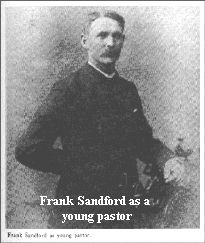
Synthesis
"To be sure, with the ideas and doctrines from so many sources, he bridged some substantial theological chasms. Mrs. Smith's perfectionism carried an antinomian taint that usually repelled conservative millenarians; yet because they did not expect the church to survive the Tribulation, they looked for the influence of the Holy Spirit on individuals and were thus drawn into an individual ethic of holiness and sanctification. Likewise, since the millenarians were looking for a worldwide catastrophe, they generally did not approve of the notion of American or English manifest destiny which appealed to optimistic millennialists; Sandford would successfully merge the two doctrines by viewing Anglo-America as the "lost tribes of Israel," stiff-necked, rebellious, deserving of God’s punishment, yet still God’s chosen people and rod for the nations." Hiss p.77